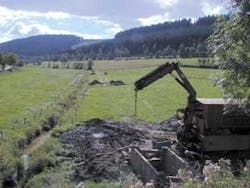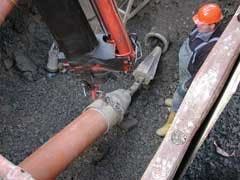Berstlining project renews sewage collector
TRACTO-TECHNIK’s Grundoburst technology helps save 30% in anticipated costs and shortens project schedule by three weeks.
Two German companies Müsse GmbH (Erndtebrück) and Spiekermann (Schmallenberg), completed a sewage pipeline replacement job using the berstlining method three weeks early and saved 30% in costs compared with the open trenching method.
Built in 1973, the 1.1-kilometre-long collector in Erndtebrück and connection collector to the treatment plant 2.5-km away, showed immense damage with high external water infiltration. The rate of external water rose so high in the treatment plant that even a newly installed third pump could hardly cope with the water volume at peak times.
The Erndtebrück City Council had to consider the short- and long-term costs in ensuring that the treatment plant could cope with the high volume, or the possibility of failing to provide adequate treatment in the case of an overflow. The long, effective use of the canal had to be guaranteed, which had a decisive influence on annual costs. Sanitation investment is depreciated over a period of time and is considered part of annual costs. These costs rank high in the budget of network operators given that they represent 67% of total costs.
This situation forced a quick decision to apply the berstlining method. The application of this method destroys the old bore path when pulling in a bursting tool, expands the path, and then directly pulls into position the often larger new pipe.
The council contracted Müsse GmbH in co-operation with the company Spiekermann, who had already been working with the Grundoburst machine technology of manufacturer’s Tracto-Technik GmbH from Lennestadt, Germany, to repair the pipe channel. The key feature of this technology is the QuickLock bursting rod, which is not screwed together, but simply hooked on. This method helped the contractors complete the project much more quickly than anticipated.
The contractors burst open the stoneware canal ND 250 over reach lengths between 200 m and 250 m and renewed the canal with a PP-HM pipe of the same size, by butt-welding the long pipes, in one working step. Intermediate pits in the reach length were driven through and at the end of the lengths new manholes made of HDPE (Uponor system) were placed in position. Müsse and Spiekermann carried out the renewal of the adjacent house connections simultaneously.
This trenchless technology method helped shorten the project length by three weeks earlier than initially planned. In contrast to the traditional, open trenching method, the TRACTO-TECHNIK’s berstlining method saved more than 30% of costs. In addition, the application of polyethylene (PE) and PP-HM material for the new pipes translates into an effective life duration of approximately 80 years and a totally sealed pipe channel. Finally, completion of the berstlining project will lower treatment plant costs given that the renewed sewer pipe canal seals off any external water content so operation costs are minimised and sewer charges are not affected.
Author’s Note
Export Manager Carola Schmidt of TRACTO-TECHNIK GmbH is based in Lennestad./Germany For more information, contact Email: [email protected]
Pipe rehabilitation methods developed
Water, sewer or gas mains have often suffered severe breakages due to pipe corrosion, tree roots, pipe settlements or inaccurate pipe joints. Since 1981, Tracto-Technik has employed its two patented, main pipe replacement systems - Grundocrack pneumatic pipe cracking and Grundoburst static hydraulic pipe rehabilitation - on several hundred thousand metres of pipes.
Grundocrack pneumatic pipe cracking equipment is used for all brittle pipe materials (plastic, asbestos cement, clay, concrete) while the new pipes to be installed are mostly made from HD-PE or to a lesser degree from PVC. These machines are used primarily in the European gas and drinking market, but the US market for Grundocrack equipment has been developing strongly in the sewage market.
The Grundoburst static hydraulic pipe rehabilitation process is used for replacing virtually all old pipes including steel and ductile iron pipes. The current range includes rigs with 40, 80, 125 and 250 tons of pull-back. Contrary to pneumatic pipe cracking operations, the use of a winch is not required. Due to their limited dimensions, the system requires very small entry pits. Custom-designed, heavy-duty solid steel rods with non-locking threads are thrust into the old pipe until a full string of rods is created. The TT-patented QuickLock rods save time, reduce the number of operators on the job, and are maintenance- and wear-free. On arrival of the string of rods in the target area, up to 400, 800, 1250 and 2500 kN are applied to fracture the old pipe into small fragments while installing the new pipe. The special design of the steel rods enables the change-over to another rod without stopping the bursting progress, leading to considerable savings.


